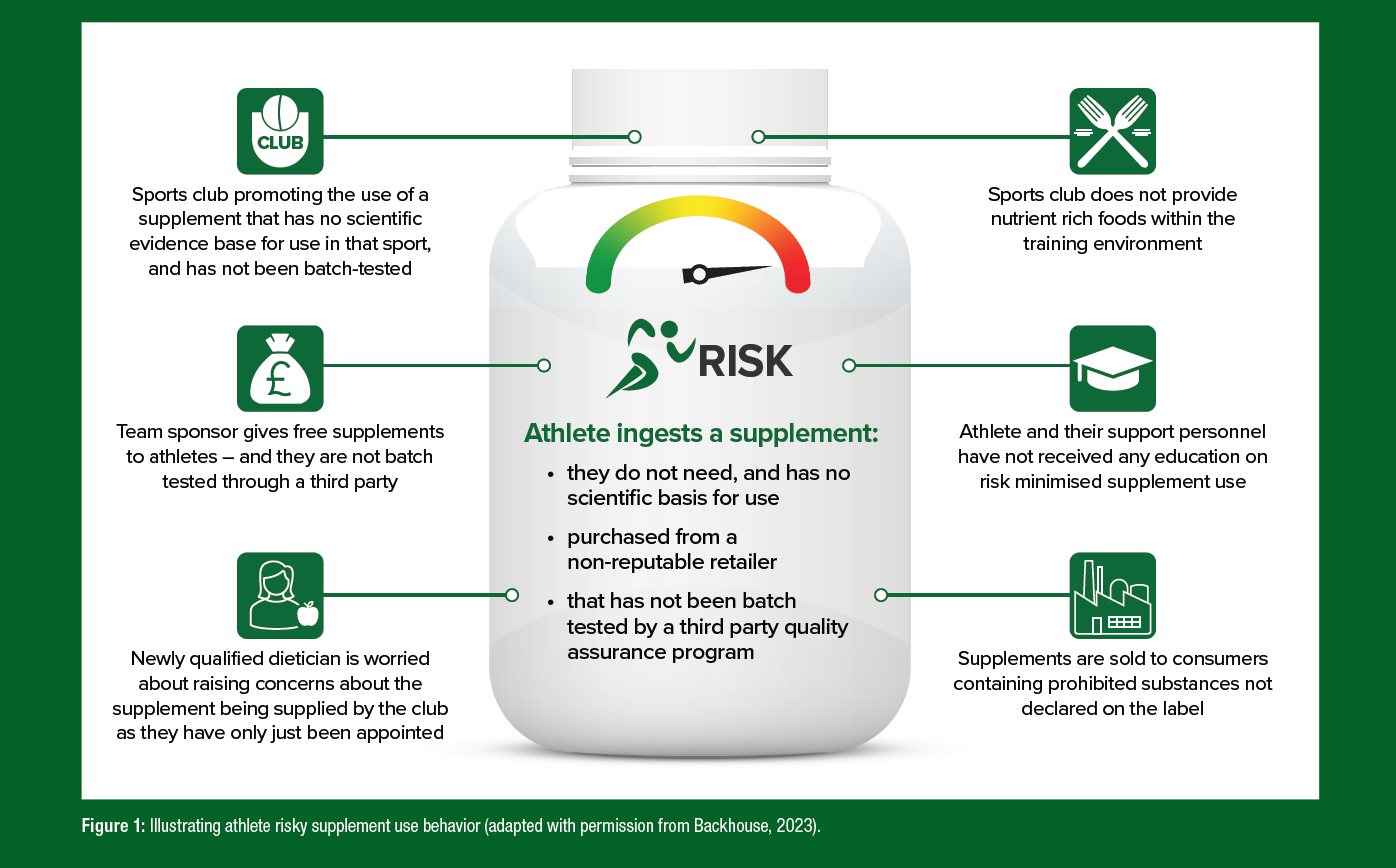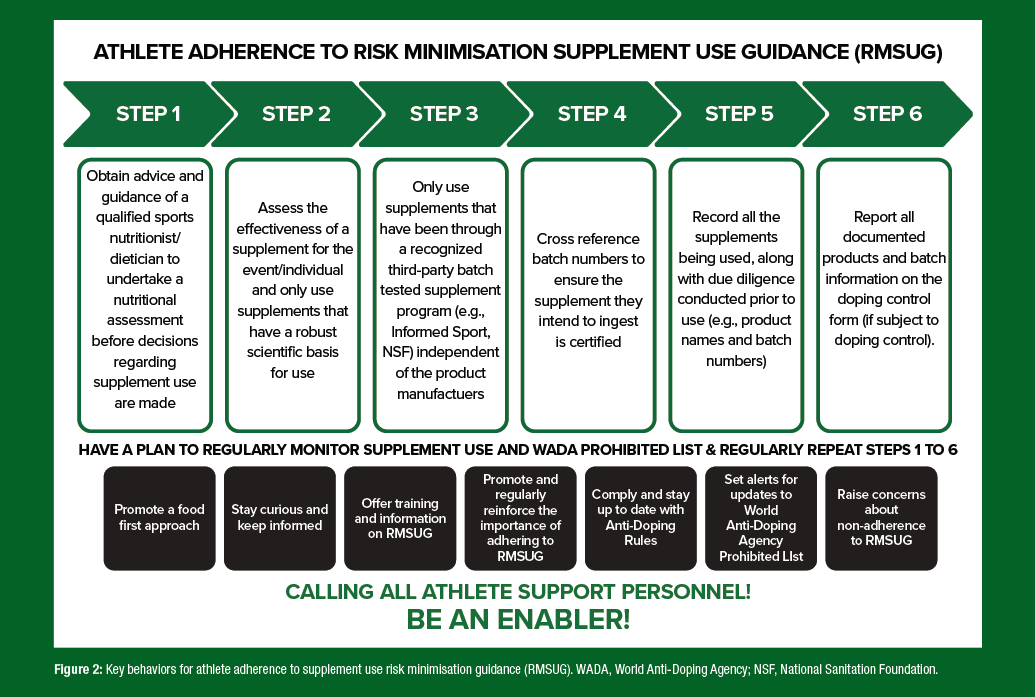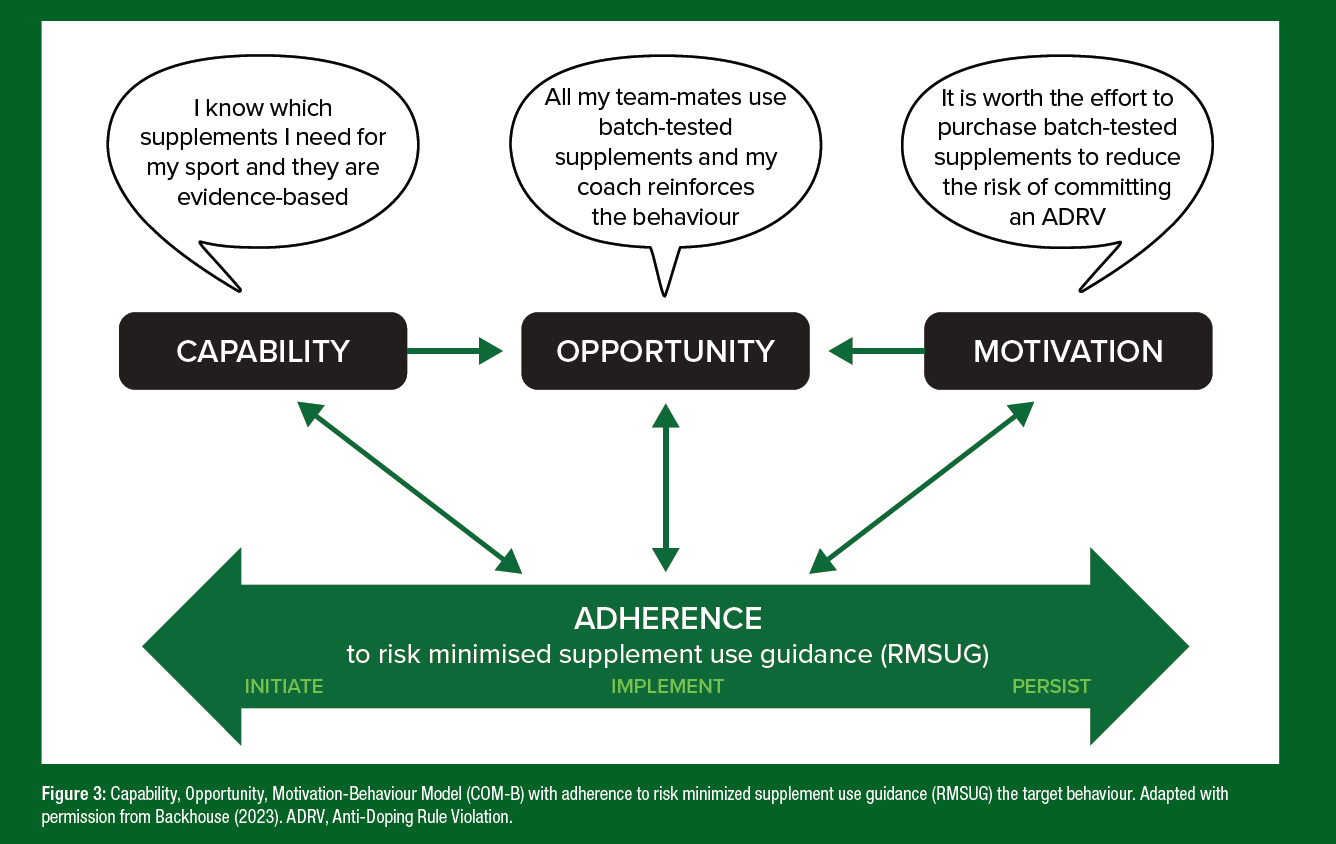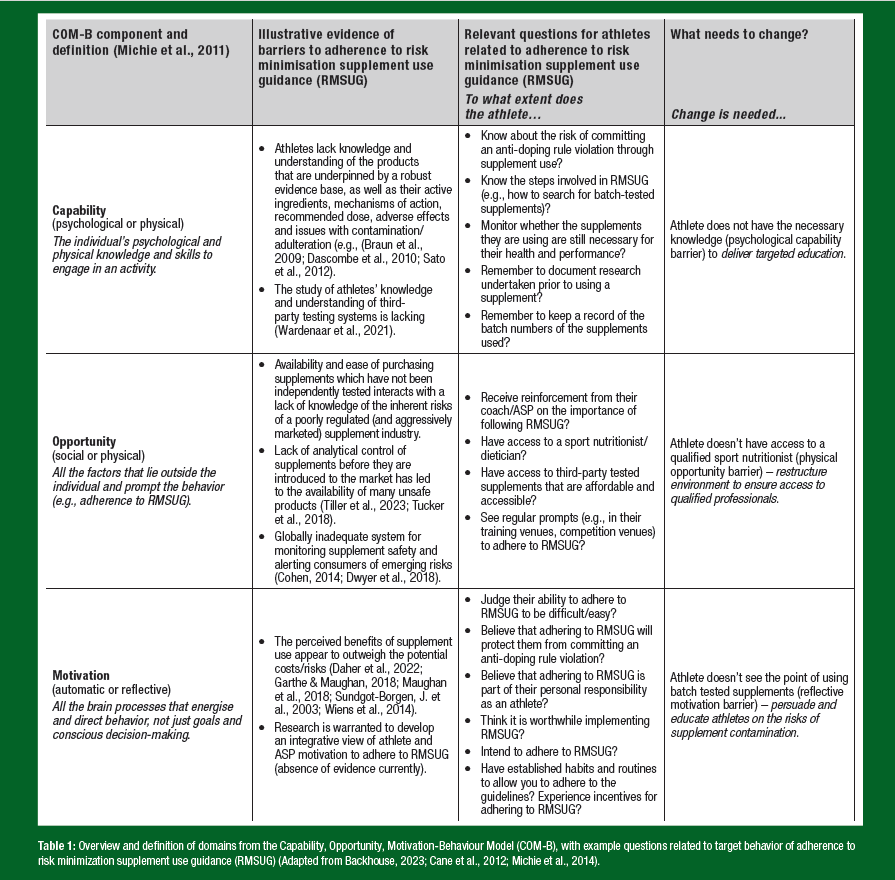KEY POINTS
- Athletes’ use of supplements is highly prevalent across sport and competitive levels. High prevalence is combined with indiscriminate use. This remains a concern in sport as it can lead to negative health effects and the risk of committing an anti-doping rule violation.
- Consequences of committing an anti-doping rule violation through supplement use are significant for competitive athletes (e.g., ineligibility from major competitions, loss of medals and funding) due to the principle of strict liability (if it is in the athlete’s body, the athlete is responsible for it).
- The principle of strict liability interacts with a growing and professionally marketed industry that is poorly regulated. Consequently, competitive athletes can find themselves in a vulnerable and risky position when it comes to consuming supplements.
- Where risk-benefit analysis supports the use of a supplement, it is critical that athletes adhere to risk minimized supplement use guidance (RMSUG) published by a professional body or organization (e.g., International Olympic Committee Consensus Statement on Supplements).
- Athletes must have the capability (e.g., knowledge and skills), opportunity (e.g., physical access, social support) and motivation (e.g., beliefs and habits) to adhere to RMSUG.
- Adopting a behavioral approach to understanding adherence to RMSUG helps us identify what needs to change to protect athletes from unintentionally doping through indiscriminate supplement use.
INTRODUCTION
The supplement industry has expanded at an alarming rate, exceeding the capacity of government agencies to regulate the market and protect the consumer (Tiller et al., 2023). Consequently, many products are sold on exaggerated claims and questionable evidence of safety and efficacy (Maughan et al., 2018; Tiller et al., 2023), with few supplements underpinned by an established evidence base (Australian Institute for Sport, 2022; Maughan et al., 2018; Peeling et al., 2018). The indiscriminate use of supplements by competitive athletes remains a concern in sport due to the ever-present risk of contamination and/ or adulteration of supplements with prohibited substances (Duiven et al., 2021; Geyer et al., 2003); putting athletes in a vulnerable position of breaking World Anti-Doping Agency (WADA) rules (Backhouse & Whitaker, 2016; Whitaker & Backhouse, 2017) and experiencing negative health effects (Cohen, 2014; Geller et al., 2015; Knapik et al., 2022).
Whilst the magnitude of anti-doping rule violations (ADRVs) associated with supplement use is not yet known (Lauritzen, 2022), the risk of prohibited substances in supplements has persisted for more than two decades (Duiven et al., 2021). Consequently, athletes have long been warned by national and international anti-doping organisations about the risks of violating anti-doping rules through supplement use. The risk of committing an inadvertent ADRV through the use of supplements has been deemed to be a “small but real problem facing athletes who compete in events governed by anti-doping rules” (p.1) (Baylis et al., 2001). Currently, it is not possible to quantify the scale of this behavioral problem, but some estimations have been made. Approximately 6% to 9% of reported doping cases are the result of athletes ingesting supplements containing prohibited substances (Outram & Stewart, 2015).
Whilst pre-market legislative and regulatory changes are needed to ensure only safe and effective products are available to supplement users, a global shift of this magnitude is a long way off (Dwyer et al., 2018). Given this challenging and incongruent landscape, athletes and their athlete support personnel (ASP) need guidance and support to navigate this context and adhere to risk minimized supplement use guidance (RMSUG), when risk-benefit analysis supports use (Garthe & Maughan, 2018). Such guidance is provided by professional bodies as non-adherence to RMSUG can lead to serious consequences for athletes. This Sport Science Exchange (SSE) article examines these issues.
Figure 1 provides an example of the interdependence of behaviors related to ‘risky’ supplement use (i.e., not following RMSUG). For example, Figure 1 highlights the influence of significant others around the athlete and widens the lens through which we view the problem; moving beyond athlete blame and shame when it comes to unintentional ADRVs associated with supplement use.

SUPPLEMENT USE IN SPORT
Definitions and prevalence
Supplements are found in pill, capsule, powder or liquid form and contain dietary ingredients (e.g., vitamins, minerals, amino acids, botanicals) that can affect the body (Maughan et al., 2018). They are typically described as “foods, food components, nutrients or non-food compounds purposefully ingested in addition to the habitually consumed diet with the aim of achieving a specific health and/or performance benefit” (Maughan et al., 2018). These functional effects on the body can drive many athletes to use a variety of supplements to manage the physical and social demands of sport and enhance their performance and recovery (Close et al., 2022; Garthe & Ramsbottom, 2020).
The use of supplements across sport, countries and competitive levels is commonplace (Garthe & Maughan, 2018; Maughan et al., 2018), with higher use at elite levels reported. The most recent systematic review and meta-analysis targeting athletes reported an overall prevalence of supplement use of ~60% among various sporting populations (Knapik et al., 2016). Previous reviews have estimated the prevalence of supplement use among athletes ranges between 11% and 100%, depending on several factors including the level of competition, type of sport and the definition of supplement use (Daher et al., 2022; Garthe & Maughan, 2018).
THE PROBLEM OF UNINTENTIONAL DOPING THROUGH SUPPLEMENT USE
Principle of strict liability
Strict liability is the keystone of the World Anti-Doping Code (WADA, 2021), the core document that harmonizes anti-doping policies, rules and regulations within sport organizations and among public authorities around the world. Underpinning Article 2 of the Code is the statement that it is an athlete’s personal duty to ensure that no prohibited substance enters his or her body (WADA, 2021). This means that an athlete can be judged to have committed an ADRV whether or not the athlete intentionally or unintentionally used a prohibited substance or was otherwise negligent or at fault. Whilst the Code makes a provision for the avoidance or reduction in sanction if the athlete can satisfactorily establish how the substance unintentionally entered their system, ignorance is not accepted as an excuse.
The industry and risk of supplement contamination and adulteration
The principle of strict liability interacts with a growing and professionally marketed industry that is poorly regulated (Cohen, 2014; Dwyer et al., 2018). Under these conditions, competitive athletes (as consumers) and ASP can find themselves in a vulnerable and risky position when it comes to consuming supplements. The consequence of supplements being classified as a subcategory of food in many countries is that manufacturers do not need to provide evidence of product safety and efficacy compared, for example, with medications (Cohen, 2014). Moreover, supplements are easily purchased by the consumer without prescription or healthcare professional intervention (Dwyer et al., 2018). It is within the context of a complex adaptive supplement system that a prohibitive approach to supplement use has framed anti-doping organization programs (Backhouse et al., 2019), accompanied by ‘food first’ appeals.
It is important to acknowledge that whilst a ‘food first’ approach is a goal of an evidence-based sport nutrition plan (Australian Institute for Sport, 2022), some supplements can play a small but valuable role in an evidence-based sport nutrition plan (Close et al., 2022; Maughan et al., 2018; Peeling et al., 2018). Consequently, when supported by qualified professionals there is growing recognition that ‘food first, but not always ‘food only’ is a more pragmatic and evidence-based strategy for athletes (Close et al., 2022). For example, some foods may be difficult to consume immediately before, during or immediately after exercise (Close et al., 2022).
ADHERENCE TO RISK MINIMIZED SUPPLEMENT USE GUIDANCE (RMSUG)
Where risk-benefit analysis supports the use of a supplement, athletes must adhere to RMSUG published by a professional body or organization, such as the International Olympic Committee (IOC) (Maughan et al., 2018), British Dietetics Association (British Dietetics Association Sports Nutrition Group, 2022), Australian Institute of Sport (Australian Institute for Sport, 2022) and US Anti-Doping Agency (US Anti-Doping Agency, 2023). Across all RMSUG, athletes are generally cautioned to behave in a number of different ways (Figure 2). For example, athletes should only use supplements that they need (and are evidence-based), present minimal risk of containing a prohibited substance, and are recorded and monitored, to lessen the likelihood of committing an inadvertent ADRV. Adherence to these behavioral steps helps to minimize the risk of unintentional doping and provides evidence that athletes were not at fault/negligent if an adverse analytical finding arises through supplement use (i.e., due diligence). To undertake these behaviors as a matter of habit and routine, conscious effort and vigilance by athletes are required (with support from their team) (Figure 2).

Enabling athletes to adhere to RMSUG
To enable adherence to RMSUG, the Capability, Opportunity, Motivation Model of Behavior (COM-B) (Michie et al., 2011, Figure 3) posits that competitive athletes must have the:
- Capability to ensure the supplements they use are necessary, evidence-based, effective (for their sport/context) and free from contaminants/adulterants.
- Opportunity to receive assessment/advice from a qualified sport nutritionist/dietician and purchase evidence-based, third-party tested supplements (e.g., via easy access to affordable products, supported by their social group).
- Motivation to seek advice, and only ingest evidence-based, third-party tested supplements over a possibly cheaper and more accessible and aggressively marketed product that has not been deemed effective or independently tested.
All three components are essential in eliciting behavior, so if any of the components is weak or lacking, adherence to RMSUG has a lower likelihood of occurrence (Michie et al., 2011). Having high COM would lead to the successful performance of behavior (see Figure 3 for a visual representation of the COM-B to RMSUG adherence behavior).
Identifying barriers to adherence to RMSUG
To help structure your thinking and develop athlete support, the COM-B model allows you to identify perceived psychological and behavioral barriers to adherence to RMSUG. To help explore the blockers athletes may face, refer to the questions in Table 1 as a starting point. This process is important because to prevent unintentional doping through supplement use, interventions need to be designed with an understanding of what drives athlete and ASP behavior in relation to RMSUG adherence. In developing this understanding, it is important to recognize that athlete behavior affects, and is affected by, a complex range of social influences and nested environmental interactions, as indicated in the change column of Table 1. Therefore, this understanding should be framed by a socio-ecological perspective (individual, interpersonal, organizational, community, policy). Following this behavioral diagnosis process, it is possible to identify the broad types of intervention that will bring about change, matched to the COM-B diagnosis. For example, the change column of Table 1 highlights that this preliminary COM-B analysis of the factors influencing adherence to RMSUG revealed: (i) Capability related factors, such as athletes lack of knowledge about the risks of supplement product contamination/ adulteration, (ii) Opportunity related factors, including lack of access to qualified nutritionists/dieticians and (iii) Motivation related factors including perceived threat of detection if a prohibited substances is consumed through supplement use.

SUMMARY AND PRACTICAL APPLICATIONS
Recognizing that supplement use is highly prevalent across sport, despite the risks and consequences that can arise from indiscriminate consumption, this SSE article provides an integrated behavioral approach to helping athletes adhere to RMSUG. In doing so, it helps to shine a light on the barriers and enablers of RMSUG to guide the development of targeted and tailored interventions. The COM-B model helps us make sense of our complex human behaviors and understand how decisions are made and what drives behavior. Once an understanding has been gained, it is possible to influence the athlete and ASP behaviors through the design of effective interventions. However, it is important to recognize that even if athletes (and athlete support personnel) intend to adhere to RMSUG, it takes commitment, time and effort to overcome barriers and make a successful and lasting change.

The views expressed are those of the author and do not necessarily reflect the position or policy of PepsiCo, Inc.
REFERENCES
Australian Institute for Sport (2022). Australian Institute of Sport (AIS) Position Statement: Supplements and Sports Foods in High Performance Sport. https://www.ais.gov.au/__ data/assets/pdf_file/0014/1000841/Position-Statement-Supplements-and-Sports- Foods.pdf
Backhouse, S.H. (2023). A behaviourally informed approach to reducing the risk of inadvertent anti-doping rule violations from supplement use. Sports Med. In Press.
Backhouse, S., and L. Whitaker (2016). Nutritional supplements in sport: Prevalence, reasons for use, and relation to doping. In: The Psychology of Doping in Sport. Routledge/Taylor & Francis Group. (pp. 183–198).
Backhouse, S.H., E. Duiven, H. Staff, and M. Bentley (2019). Reducing the risk of inadvertent doping from food supplement use: Current practice and future actions. In: FAIR Forum for Anti-Doping in Recreational Sport. https://ec.europa.eu/programmes/erasmus-plus/project-result-content/5d7860db-eda6-4a62-830b-f5958c292e67/FAIR_ Final_Report.pdf
Baylis, A., D. Cameron-Smith, and L.M. Burke (2001). Inadvertent doping through supplement use by athletes: Assessment and management of the risk in Australia. Int. J. Sport Nutr. Exerc. Metab. 11:365–383.
Braun, H., K. Koehler, H. Geyer, J. Kleinert, J. Mester, and W. Schänzer (2009). Dietary supplement use among elite young german athletes. Int. J. Sport Nutr. Exerc. Metab. 19:97–109.
British Dietetics Association Sports Nutrition Group (2022). Nutritional Supplement Position Statement. Retrieved 19 December 2022, from https://www.bda.uk.com/uploads/ assets/b7c89c32-40d8-4f66-9449aae9fc8c81cc/SNG-Supplement-Position- Statement-2022.pdf.
Cane, J., D. O’Connor, and S. Michie (2012). Validation of the theoretical domains framework for use in behaviour change and implementation research. Implement. Sci. 7:37.
Close, G.L., A.M. Kasper, N.P. Walsh, and R.J. Maughan (2022). Food first but not always food only: Recommendations for using dietary supplements in sport. Int. J. Sport Nutr. Exerc. Metab. 32: 371–386.
Cohen, P.A. (2014). Hazards of hindsight—Monitoring the safety of nutritional supplements. N. Engl. J. Med. 370:1277–1280.
Daher, J., M. Mallick, and D. El Khoury (2022). Prevalence of dietary supplement use among athletes worldwide: A scoping review. Nutrients 14:4109.
Dascombe, B.J., M. Karunaratna, J. Cartoon, B. Fergie, and C. Goodman (2010). Nutritional supplementation habits and perceptions of elite athletes within a state-based sporting institute. J. Sci. Med. Sport 13:274–280.
Duiven, E., L.J.C. van Loon, L. Spruijt, W. Koert, and O.M. de Hon (2021). Undeclared doping substances are highly prevalent in commercial sports nutrition supplements. J. Sports Sci. Med. 20:328–338.
Dwyer, J.T., P.M. Coates, and M.J. Smith (2018). Dietary supplements: Regulatory challenges and research resources. Nutrients 10:41.
Garthe, I., and R.J. Maughan (2018). Athletes and supplements: Prevalence and perspectives. Int. J. Sport Nutr. Exerc. Metab. 28:126–138.
Garthe, I., and R. Ramsbottom (2020). Elite athletes, a rationale for the use of dietary supplements: A practical approach. PharmaNutr. 14:100234.
Geller, A.I., N. Shehab, W.J. Weidle, M.C. Lovegrove, B.J. Wolpert, B.B. Timbo, R.P. Mozersky, and D.S. Budnitz (2015). Emergency department visits for adverse events related to dietary supplements. N. Engl. J. Med. 373:1531–1540.
Geyer, H., M. Bredehöft, U. Mareck, M. Parr, and W. Schänzer (2003). High doses of the anabolic steroid metandienone found in dietary supplements. Eur. J. Sport Sci. 3:1–5.
Knapik, J.J., R.A. Steelman, S.S. Hoedebecke, K.G. Austin, E.K. Farina, and H.R. Lieberman (2016). Prevalence of dietary supplement use by athletes: Systematic review and meta-analysis. Sports Med. 46:103–123.
Knapik, J.J., D.W. Trone, R.A. Steelman, E.K. Farina, and H.R. Lieberman (2022). Adverse effects associated with use of specific dietary supplements: The US Military dietary supplement use study. Food Chem. Tox. 161:112840.
Lauritzen, F. (2022). Dietary supplements as a major cause of anti-doping rule violations. Front. Sports Act. Living 4:868228
Maughan, R.J., L.M. Burke, J. Dvorak, D.E. Larson-Meyer, P. Peeling, S.M. Phillips, E.S. Rawson, N.P. Walsh, I. Garthe, H. Geyer, R. Meeusen, L.J.C. van Loon, S.M. Shirreffs, L.L. Spriet, M. Stuart, A. Vernec, K. Currell, V.M. Ali, R.G. Budgett, and L. Engebretsen (2018). IOC consensus statement: Dietary supplements and the high-performance athlete. Br, J. Sports Med. 52:439–455.
Michie, S., M.M. van Stralen, and R. West (2011). The behaviour change wheel: A new method for characterising and designing behaviour change interventions. Implement. Sci. 6:42.
Michie, S., L. Atkins, and R. West (2014). The Behaviour Change Wheel Book—A Guide To Designing Interventions. Silverback Publishing. http://www.behaviourchangewheel. com/
Outram, S., and B. Stewart (2015). Doping through supplement use: A review of the available empirical data. Int. J. Sport Nutr. Exerc. Metab. 25:54–59.
Peeling, P., M.J. Binnie, P.S.R. Goods, M. Sim, and L.M. Burke (2018). Evidence-based supplements for the enhancement of athletic performance. Int. J. Sport Nutr. Exerc. Metab. 28:178–187.
Sato, A., A. Kamei, E. Kamihigashi, M. Dohi, Y. Komatsu, T. Akama, and T. Kawahara (2012). Use of supplements by young elite Japanese athletes participating in the 2010 youth Olympic games in Singapore. Clin. J. Sport Med. 22:418.
Sundgot-Borgen, J., B. Berglund, and M.K. Torstveit (2003). What drives athletes toward dietary supplement use: Objective knowledge or ...: EBSCOhost. Scand. J. Med. Sci. Sports, 13:138–144.
Tiller, N.B., J.P. Sullivan, and P. Ekkekakis (2023). Baseless claims and pseudoscience in health and wellness: a call to action for the sports, exercise, and nutrition-science community. Sports Med. 53:1–5.
Tucker, J., T. Fischer, L. Upjohn, D. Mazzera, and M. Kumar, M. (2018). Unapproved pharmaceutical ingredients included in dietary supplements associated with US Food and Drug Administration Warnings. J. Am. Med. Assoc. Open 1:e183337.
US Anti-Doping Agency (2023). Supplement Guide: Reducing Supplement Risk. Retrieved 17 April 2023, from https://www.usada.org/wp-content/uploads/supplement-guide.pdf.
Wardenaar, F.C., D. Hoogervorst, K.A. Vento, and O. de Hon (2021). Dutch Olympic and non- Olympic athletes differ in knowledge of and attitudes toward third-party supplement testing. J. Diet. Suppl. 18:646–654.
Whitaker, L., and S. Backhouse (2017). Doping in sport: An analysis of sanctioned UK rugby union players between 2009 and 2015. J. Sports Sci. 35:1607–1613.
Wiens, K., K.A. Erdman, M. Stadnyk, and J.A. Parnell (2014). Dietary supplement usage, motivation, and education in young Canadian athletes. Int. J. Sport Nutr. Exerc. Metab. 24:613–622.
World Anti-Doping Agency (2021). World Anti-Doping Code 2021. https://www.wada-ama. org/sites/default/files/resources/files/2021_wada_code.pdf